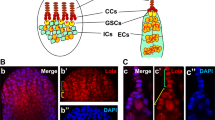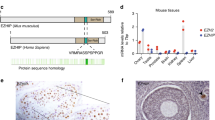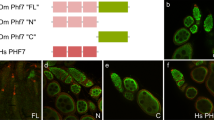Abstract
The Drosophila melanogaster Piwi protein regulates both niche and intrinsic mechanisms to maintain germline stem cells, but its underlying mechanism remains unclear. Here we report that Piwi interacts with Polycomb group complexes PRC1 and PRC2 in niche and germline cells to regulate ovarian germline stem cells and oogenesis. Piwi physically interacts with the PRC2 subunits Su(z)12 and Esc in the ovary and in vitro. Chromatin coimmunoprecipitation of Piwi, the PRC2 enzymatic subunit E(z), histone H3 trimethylated at lysine 27 (H3K27me3) and RNA polymerase II in wild-type and piwi mutant ovaries demonstrates that Piwi binds a conserved DNA motif at ∼72 genomic sites and inhibits PRC2 binding to many non-Piwi-binding genomic targets and H3K27 trimethylation. Moreover, Piwi influences RNA polymerase II activities in Drosophila ovaries, likely via inhibiting PRC2. We hypothesize that Piwi negatively regulates PRC2 binding by sequestering PRC2 in the nucleoplasm, thus reducing PRC2 binding to many targets and influencing transcription during oogenesis.
This is a preview of subscription content, access via your institution
Access options
Subscribe to this journal
Receive 12 print issues and online access
$209.00 per year
only $17.42 per issue
Buy this article
- Purchase on Springer Link
- Instant access to full article PDF
Prices may be subject to local taxes which are calculated during checkout






Similar content being viewed by others
Accession codes
References
Deng, W. & Lin, H. Asymmetric germ cell division and oocyte determination during Drosophila oogenesis. Int. Rev. Cytol. 203, 93–138 (2001).
Cox, D.N. et al. A novel class of evolutionarily conserved genes defined by piwi are essential for stem cell self-renewal. Genes Dev. 12, 3715–3727 (1998).
Lin, H. & Spradling, A.C. A novel group of pumilio mutations affects the asymmetric division of germline stem cells in the Drosophila ovary. Development 124, 2463–2476 (1997).
Smulders-Srinivasan, T.K. & Lin, H. Screens for piwi suppressors in Drosophila identify dosage-dependent regulators of germline stem cell division. Genetics 165, 1971–1991 (2003).
Smulders-Srinivasan, T., Szakmary, A. & Lin, H.A. Drosophila chromatin factor interacts with the piRNA mechanism in niche cells to regulate germline stem cell self-renewal. Genetics 186, 573–583 (2010).
Kodjabachian, L. et al. Mutations in ccf, a novel Drosophila gene encoding a chromosomal factor, affect progression through mitosis and interact with Pc-G mutations. EMBO J. 17, 1063–1075 (1998).
Lopez, A., Higuet, D., Rosset, R., Deutsch, J. & Peronnet, F. corto genetically interacts with Pc-G and trx-G genes and maintains the anterior boundary of Ultrabithorax expression in Drosophila larvae. Mol. Genet. Genomics 266, 572–583 (2001).
Salvaing, J., Lopez, A., Boivin, A., Deutsch, J.S. & Peronnet, F. The Drosophila Corto protein interacts with Polycomb-group proteins and the GAGA factor. Nucleic Acids Res. 31, 2873–2882 (2003).
Grimaud, C. et al. RNAi components are required for nuclear clustering of Polycomb group response elements. Cell 124, 957–971 (2006).
Pal-Bhadra, M., Bhadra, U. & Birchler, J.A. Cosuppression in Drosophila: gene silencing of Alcohol dehydrogenase by white-Adh transgenes is Polycomb dependent. Cell 90, 479–490 (1997).
Pal-Bhadra, M., Bhadra, U. & Birchler, J.A. RNAi related mechanisms affect both transcriptional and posttranscriptional transgene silencing in Drosophila. Mol. Cell 9, 315–327 (2002).
Schuettengruber, B., Chourrout, D., Vervoort, M., Leblanc, B. & Cavalli, G. Genome regulation by polycomb and trithorax proteins. Cell 128, 735–745 (2007).
Simon, J.A. & Kingston, R.E. Mechanisms of Polycomb gene silencing: knowns and unknowns. Nat. Rev. Mol. Cell Biol. 10, 697–708 (2009).
Czermin, B. et al. Drosophila enhancer of Zeste/ESC complexes have a histone H3 methyltransferase activity that marks chromosomal Polycomb sites. Cell 111, 185–196 (2002).
Kuzmichev, A., Nishioka, K., Erdjument-Bromage, H., Tempst, P. & Reinberg, D. Histone methyltransferase activity associated with a human multiprotein complex containing the Enhancer of Zeste protein. Genes Dev. 16, 2893–2905 (2002).
Müller, J. et al. Histone methyltransferase activity of a Drosophila Polycomb group repressor complex. Cell 111, 197–208 (2002).
Cao, R. et al. Role of histone H3 lysine 27 methylation in Polycomb-group silencing. Science 298, 1039–1043 (2002).
Holdeman, R., Nehrt, S. & Strome, S. MES-2, a maternal protein essential for viability of the germline in Caenorhabditis elegans, is homologous to a Drosophila Polycomb group protein. Development 125, 2457–2467 (1998).
Korf, I., Fan, Y. & Strome, S. The Polycomb group in Caenorhabditis elegans and maternal control of germline development. Development 125, 2469–2478 (1998).
Eun, S.H., Shi, Z., Cui, K., Zhao, K. & Chen, X. A non–cell autonomous role of E(z) to prevent germ cells from turning on a somatic cell marker. Science 343, 1513–1516 (2014).
Iovino, N., Ciabrelli, F. & Cavalli, G. PRC2 controls Drosophila oocyte cell fate by repressing cell cycle genes. Dev. Cell 26, 431–439 (2013).
Peng, J.C. et al. Jarid2/Jumonji coordinates control of PRC2 enzymatic activity and target gene occupancy in pluripotent cells. Cell 139, 1290–1302 (2009).
Shen, X. et al. Jumonji modulates polycomb activity and self-renewal versus differentiation of stem cells. Cell 139, 1303–1314 (2009).
Ho, L. et al. esBAF facilitates pluripotency by conditioning the genome for LIF/STAT3 signalling and by regulating polycomb function. Nat. Cell Biol. 13, 903–913 (2011).
Aravin, A.A., Hannon, G.J. & Brennecke, J. The Piwi-piRNA pathway provides an adaptive defense in the transposon arms race. Science 318, 761–764 (2007).
Thomson, T. & Lin, H. The biogenesis and function of PIWI proteins and piRNAs: progress and prospect. Annu. Rev. Cell Dev. Biol. 25, 355–376 (2009).
Brennecke, J. et al. Discrete small RNA-generating loci as master regulators of transposon activity in Drosophila. Cell 128, 1089–1103 (2007).
Wang, J., Saxe, J.P., Tanaka, T., Chuma, S. & Lin, H. Mili interacts with Tudor domain–containing protein 1 in regulating spermatogenesis. Curr. Biol. 19, 640–644 (2009).
Chen, C. et al. Mouse Piwi interactome identifies binding mechanism of Tdrkh Tudor domain to arginine methylated Miwi. Proc. Natl. Acad. Sci. USA 106, 20336–20341 (2009).
Vagin, V.V. et al. Proteomic analysis of murine Piwi proteins reveals a role for arginine methylation in specifying interaction with Tudor family members. Genes Dev. 23, 1749–1762 (2009).
Liu, L., Qi, H., Wang, J. & Lin, H. PAPI, a novel TUDOR-domain protein, complexes with AGO3, ME31B and TRAL in the nuage to silence transposition. Development 138, 1863–1873 (2011).
Margueron, R. et al. Role of the polycomb protein EED in the propagation of repressive histone marks. Nature 461, 762–767 (2009).
Lin, H. et al. Reassessment of Piwi binding to the genome and Piwi impact on RNA polymerase II distribution. Dev. Cell 32, 772–774 (2015).
Huang, X.A. et al. A major epigenetic programming mechanism guided by piRNAs. Dev. Cell 24, 502–516 (2013).
Yin, H. & Lin, H. An epigenetic activation role of Piwi and a Piwi-associated piRNA in Drosophila melanogaster. Nature 450, 304–308 (2007).
Valouev, A. et al. Genome-wide analysis of transcription factor binding sites based on ChIP-Seq data. Nat. Methods 5, 829–834 (2008).
Mi, H., Muruganujan, A. & Thomas, P.D. PANTHER in 2013: modeling the evolution of gene function, and other gene attributes, in the context of phylogenetic trees. Nucleic Acids Res. 41, D377–D386 (2013).
Brower-Toland, B. et al. Drosophila PIWI associates with chromatin and interacts directly with HP1a. Genes Dev. 21, 2300–2311 (2007).
Lin, H. & Yin, H. A novel epigenetic mechanism in Drosophila somatic cells mediated by Piwi and piRNAs. Cold Spring Harb. Symp. Quant. Biol. 73, 273–281 (2008).
Cox, D.N., Chao, A. & Lin, H. piwi encodes a nucleoplasmic factor whose activity modulates the number and division rate of germline stem cells. Development 127, 503–514 (2000).
Yan, D. et al. A regulatory network of Drosophila germline stem cell self-renewal. Dev. Cell 28, 459–473 (2014).
Marinov, G.K. et al. Pitfalls of mapping high-throughput sequencing data to repetitive sequences: Piwi's genomic targets still not identified. Dev. Cell 32, 765–771 (2015).
Billi, A.C. et al. A conserved upstream motif orchestrates autonomous, germline-enriched expression of Caenorhabditis elegans piRNAs. PLoS Genet. 9, e1003392 (2013).
Sytnikova, Y.A., Rahman, R., Chirn, G.W., Clark, J.P. & Lau, N.C. Transposable element dynamics and PIWI regulation impacts lncRNA and gene expression diversity in Drosophila ovarian cell cultures. Genome Res. 24, 1977–1990 (2014).
Watanabe, T., Cheng, E.C., Zhong, M. & Lin, H. Retrotransposons and pseudogenes regulate mRNAs and lncRNAs via the piRNA pathway in the germline. Genome Res. 25, 368–380 (2015).
Boyer, L.A. et al. Core transcriptional regulatory circuitry in human embryonic stem cells. Cell 122, 947–956 (2005).
Bailey, T.L. & Elkan, C. Fitting a mixture model by expectation maximization to discover motifs in biopolymers. Proc. Int. Conf. Intell. Syst. Mol. Biol. 2, 28–36 (1994).
Grant, C.E., Bailey, T.L. & Noble, W.S. FIMO: scanning for occurrences of a given motif. Bioinformatics 27, 1017–1018 (2011).
Krzywinski, M. et al. Circos: an information aesthetic for comparative genomics. Genome Res. 19, 1639–1645 (2009).
Acknowledgements
We thank R. Jones (Southern Methodist University) for the E(z)63 fly stock, F. Peronnet (Institut de Biologie, Paris) for the corto420 fly stock, V. Pirotta (Rutgers University) for the antibody to Pc, H. Siomi (Keio University) for the antibody to Piwi, D. Godt (University of Toronto) for the antibody to Tj, and A. Fire and members of the Lin laboratory for assistance and discussions. We also thank H. Qi and J. Klein for experimental help, M. Reddivari for the isolation of recombinant PRC2 complex, Z. Albertyn and C. Hercus for help with Novoalign, and N. Neuenkirchen and X. Cui for critical reading. This work was supported by a US National Institutes of Health Pioneer Award (DP1CA174418) and the Mathers Award to H.L. and by a US National Institutes of Health grant (R00-HD071011) to J.C.P.
Author information
Authors and Affiliations
Contributions
J.C.P. and H.L. designed the project, analyzed the data and wrote the manuscript. J.C.P. conducted all of the experiments except for those listed in the Acknowledgments. A.V. produced all bioinformatics results in the paper and participated in manuscript writing. N.L. performed the initial bioinformatics analysis that helped guide the project.
Corresponding authors
Ethics declarations
Competing interests
The authors declare no competing financial interests.
Supplementary information
Supplementary Text and Figures
Supplementary Figures 1–9 and Supplementary Tables 1–6. (PDF 4232 kb)
Rights and permissions
About this article
Cite this article
Peng, J., Valouev, A., Liu, N. et al. Piwi maintains germline stem cells and oogenesis in Drosophila through negative regulation of Polycomb group proteins. Nat Genet 48, 283–291 (2016). https://doi.org/10.1038/ng.3486
Received:
Accepted:
Published:
Issue Date:
DOI: https://doi.org/10.1038/ng.3486
This article is cited by
-
Emerging roles and functional mechanisms of PIWI-interacting RNAs
Nature Reviews Molecular Cell Biology (2023)
-
PIWIL1 governs the crosstalk of cancer cell metabolism and immunosuppressive microenvironment in hepatocellular carcinoma
Signal Transduction and Targeted Therapy (2021)
-
Special vulnerability of somatic niche cells to transposable element activation in Drosophila larval ovaries
Scientific Reports (2020)
-
Key role of piRNAs in telomeric chromatin maintenance and telomere nuclear positioning in Drosophila germline
Epigenetics & Chromatin (2018)



